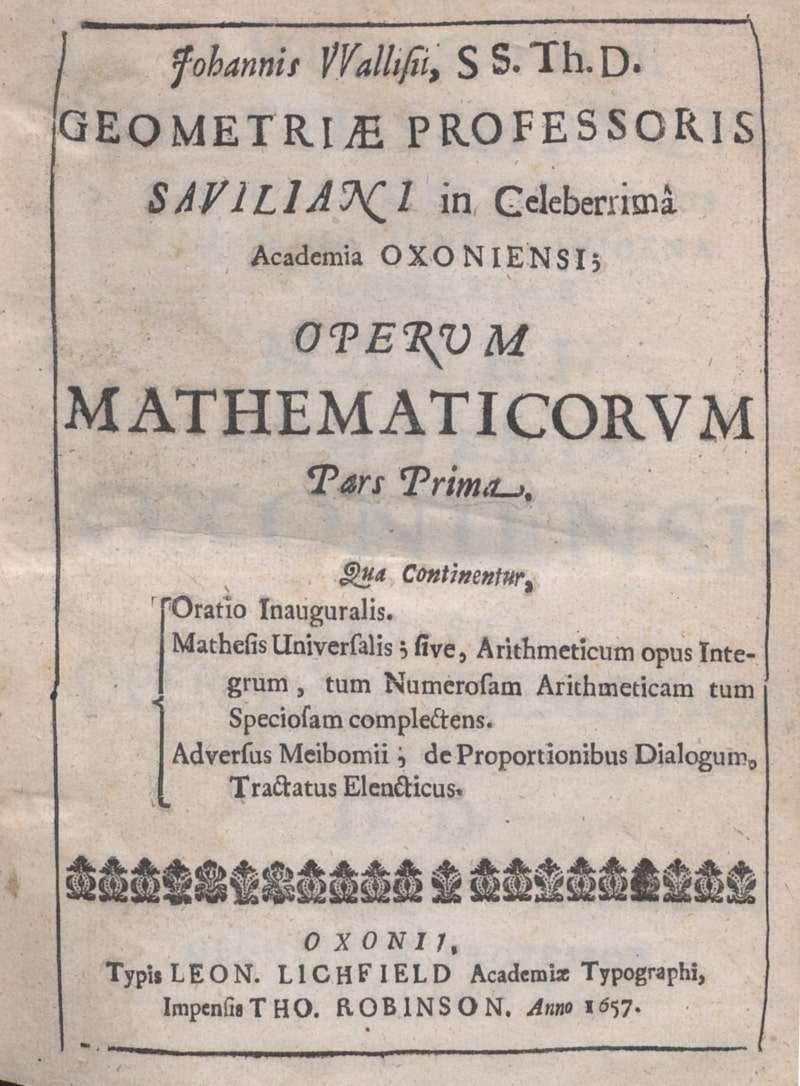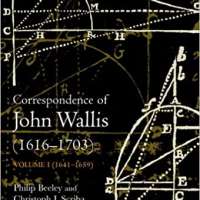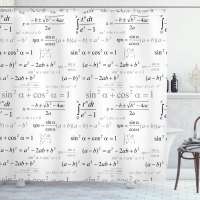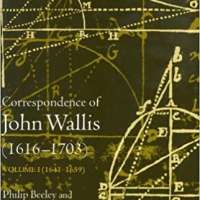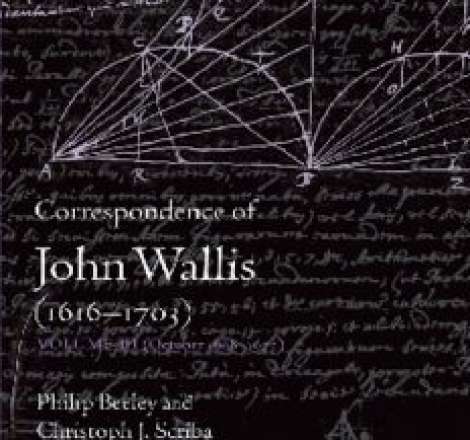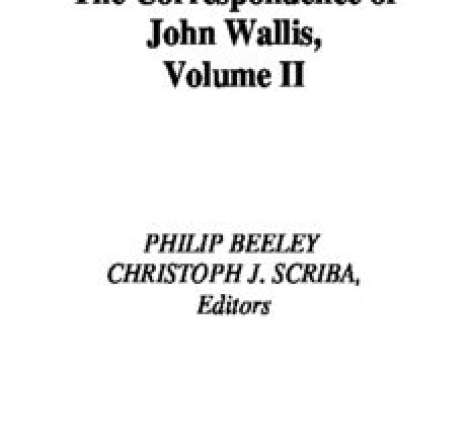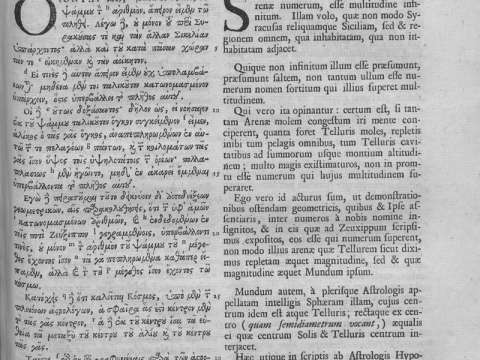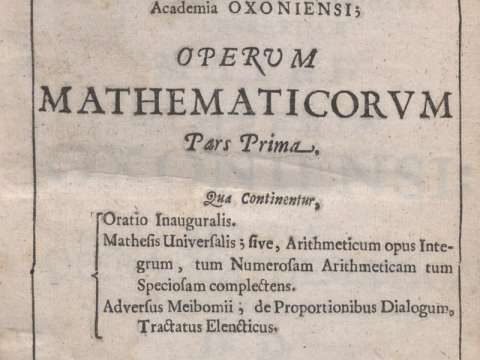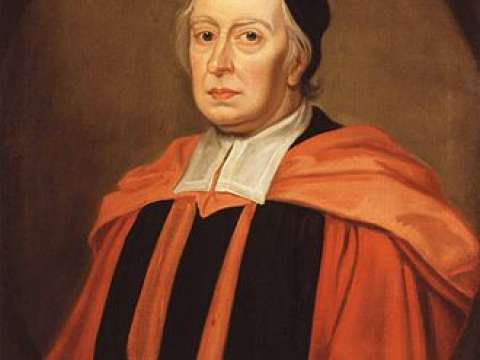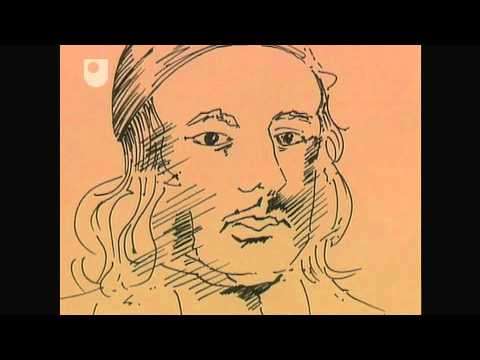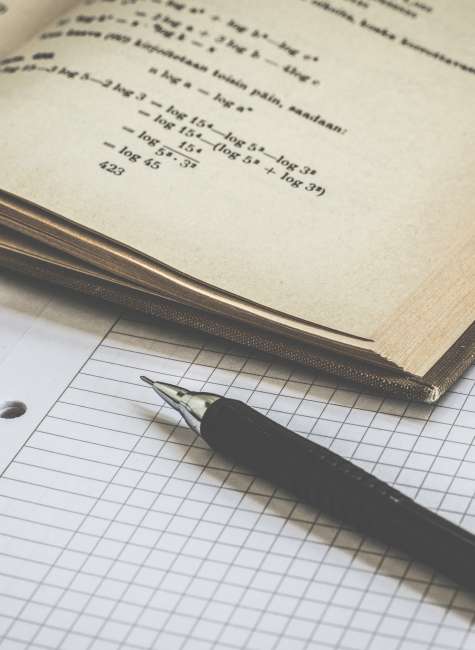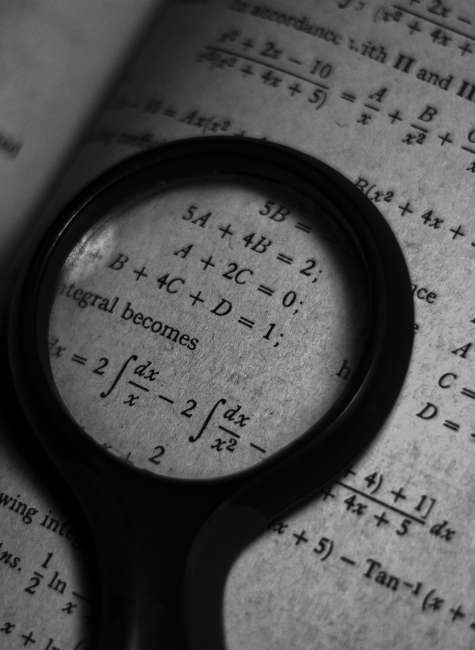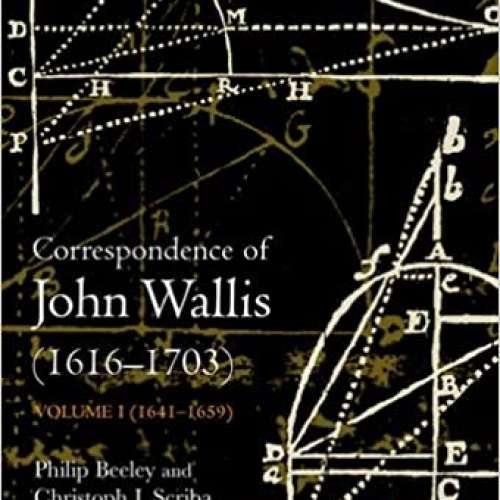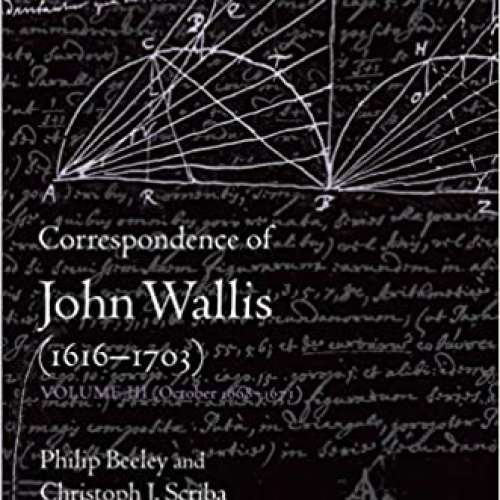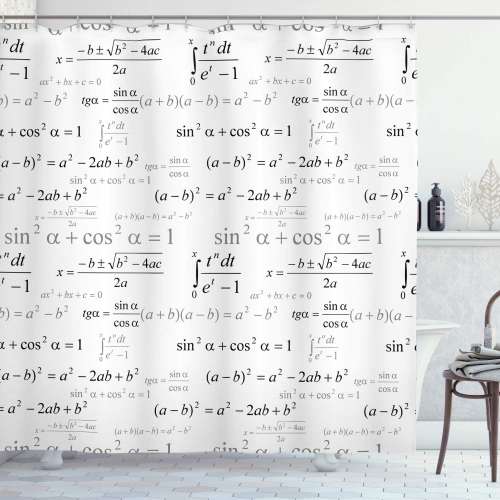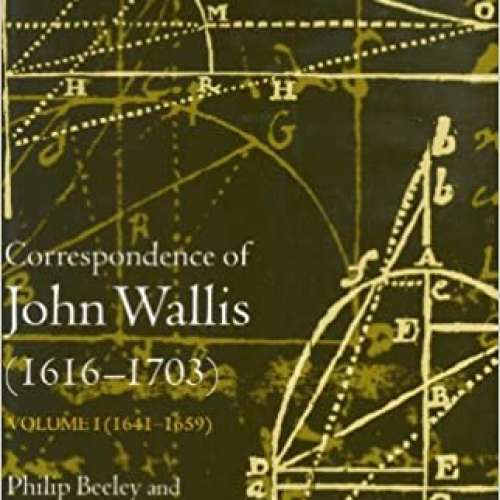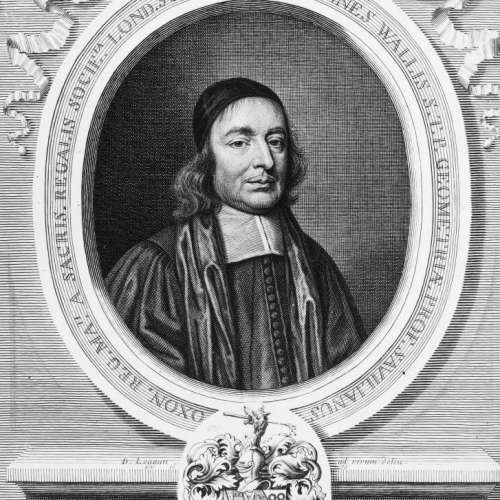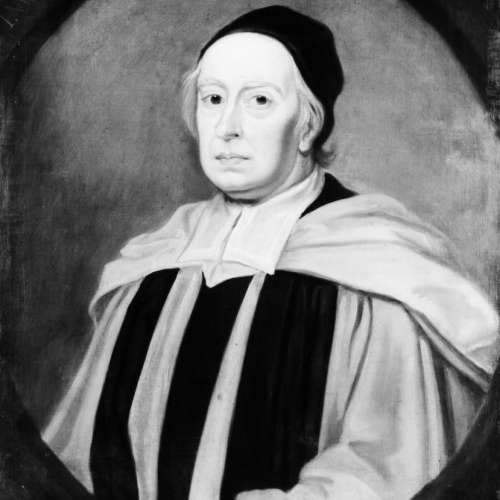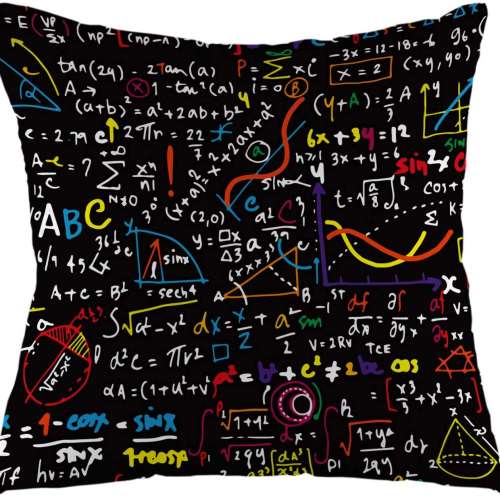

John Wallis (1616-1703)
Whereas Nature does not admit of more than three dimensions ... it may justly seem very improper to talk of a solid ... drawn into a fourth, fifth, sixth, or further dimension.
John Wallis was an English clergyman and mathematician who is given partial credit for the development of infinitesimal calculus. Between 1643 and 1689 he served as chief cryptographer for Parliament and, later, the royal court. He is credited with introducing the symbol ∞ to represent the concept of infinity. He similarly used 1/∞ for an infinitesimal. John Wallis was a contemporary of Newton and one of the greatest intellectuals of the early renaissance of mathematics.
Life
John Wallis was born in Ashford, Kent. He was the third of five children of Reverend John Wallis and Joanna Chapman. He was initially educated at a school in Ashford but moved to James Movat's school in Tenterden in 1625 following an outbreak of plague. Wallis was first exposed to mathematics in 1631, at Felsted School then known as Martin Holbeach's school in Felsted; he enjoyed maths, but his study was erratic, since "mathematics, at that time with us, were scarce looked on as academical studies, but rather mechanical" Scriba 1970. At the school in Felsted, Wallis learned how to speak and write Latin. By this time, he also was proficient in French, Greek, and Hebrew. As it was intended he should be a doctor, he was sent in 1632 to Emmanuel College, Cambridge. While there, he kept an act on the doctrine of the circulation of the blood; that was said to have been the first occasion in Europe on which this theory was publicly maintained in a disputation. His interests, however, centred on mathematics. He received his Bachelor of Arts degree in 1637 and a Master's in 1640, afterwards entering the priesthood. From 1643 to 1649, he served as a nonvoting scribe at the Westminster Assembly. He was elected to a fellowship at Queens' College, Cambridge in 1644, from which he had to resign following his marriage.
Throughout this time, Wallis had been close to the Parliamentarian party, perhaps as a result of his exposure to Holbeach at Felsted School. He rendered them great practical assistance in deciphering Royalist dispatches. The quality of cryptography at that time was mixed; despite the individual successes of mathematicians such as François Viète, the principles underlying cipher design and analysis were very poorly understood. Most ciphers were ad hoc methods relying on a secret algorithm, as opposed to systems based on a variable key. Wallis realised that the latter were far more secure – even describing them as "unbreakable", though he was not confident enough in this assertion to encourage revealing cryptographic algorithms. He was also concerned about the use of ciphers by foreign powers, refusing, for example, Gottfried Leibniz's request of 1697 to teach Hanoverian students about cryptography.
Returning to London – he had been made chaplain at St Gabriel Fenchurch in 1643 – Wallis joined the group of scientists that was later to evolve into the Royal Society. He was finally able to indulge his mathematical interests, mastering William Oughtred's Clavis Mathematicae in a few weeks in 1647. He soon began to write his own treatises, dealing with a wide range of topics, which he continued for the rest of his life. Wallis wrote the first survey about mathematical concepts in England where he discussed the Hindu-Arabic system.
Wallis joined the moderate Presbyterians in signing the remonstrance against the execution of Charles I, by which he incurred the lasting hostility of the Independents. In spite of their opposition he was appointed in 1649 to the Savilian Chair of Geometry at Oxford University, where he lived until his death on 8 November 1703. In 1650, Wallis was ordained as a minister. After, he spent two years with Sir Richard Darley and Lady Vere as a private chaplain. In 1661, he was one of twelve Presbyterian representatives at the Savoy Conference.
Besides his mathematical works he wrote on theology, logic, English grammar and philosophy, and he was involved in devising a system for teaching a deaf boy to speak at Littlecote House. William Holder had earlier taught a deaf man, Alexander Popham, to speak "plainly and distinctly, and with a good and graceful tone". Wallis later claimed credit for this, leading Holder to accuse Wallis of "rifling his Neighbours, and adorning himself with their spoyls".
Wallis' appointment as Savilian Professor of Geometry at the Oxford University
The Parliamentary visitation of Oxford that began in 1647 removed many senior academics from their positions, including in November 1648 the Savilian Professors of Geometry and Astronomy. In 1649 Wallis was appointed as Savilian Professor of Geometry. Wallis seems to have been chosen largely on political grounds as perhaps had been his Royalist predecessor Peter Turner, who despite his appointment to two professorships never published any mathematical works; while Wallis was perhaps the nation's leading cryptographer and was part of an informal group of scientists that would later become the Royal Society, he had no particular reputation as a mathematician. Nonetheless, Wallis' appointment proved richly justified by his subsequent work during the 54 years he served as Savilian Professor.
Contributions to mathematics
Wallis made significant contributions to trigonometry, calculus, geometry, and the analysis of infinite series. In his Opera Mathematica I 1695 he introduced the term "continued fraction".

Wallis rejected as absurd the now usual idea of a negative number as being less than nothing, but accepted the view that it is something greater than infinity. The argument that negative numbers are greater than infinity involves the quotient 1 x and considering what happens as x approaches and then crosses the point x = 0 from the positive side. Despite this he is generally credited as the originator of the idea of the number line, in which numbers are represented geometrically in a line with the negative numbers represented by lengths opposite in direction to lengths of positive numbers.
Analytic geometry
In 1655, Wallis published a treatise on conic sections in which they were defined analytically. This was the earliest book in which these curves are considered and defined as curves of the second degree. It helped to remove some of the perceived difficulty and obscurity of René Descartes' work on analytic geometry. In the Treatise on the Conic Sections Wallis popularised the symbol ∞ for infinity. He wrote, "I suppose any plane following the Geometry of Indivisibles of Cavalieri to be made up of an infinite number of parallel lines, or as I would prefer, of an infinite number of parallelograms of the same altitude; let the altitude of each one of these be an infinitely small part 1/∞ of the whole altitude, and let the symbol ∞ denote Infinity and the altitude of all to make up the altitude of the figure."
Integral calculus
Arithmetica Infinitorum, the most important of Wallis's works, was published in 1656. In this treatise the methods of analysis of Descartes and Cavalieri were systematised and extended, but some ideas were open to criticism. He began, after a short tract on conic sections, by developing the standard notation for powers, extending them from positive integers to rational numbers:
Leaving the numerous algebraic applications of this discovery, he next proceeded to find, by integration, the area enclosed between the curve y = xm, the axis of x, and any ordinate x = h, and he proved that the ratio of this area to that of the parallelogram on the same base and of the same height is 1/m + 1, extending Cavalieri's quadrature formula. He apparently assumed that the same result would be true also for the curve y = axm, where a is any constant, and m any number positive or negative, but he discussed only the case of the parabola in which m = 2 and the hyperbola in which m = −1. In the latter case, his interpretation of the result is incorrect. He then showed that similar results may be written down for any curve of the form

and hence that, if the ordinate y of a curve can be expanded in powers of x, its area can be determined: thus he says that if the equation of the curve is y = x + x1 + x2 + ..., its area would be x + x2/2 + x3/3 + ... He then applied this to the quadrature of the curves y = x − x2, y = x − x21, y = x − x22, etc., taken between the limits x = 0 and x = 1. He shows that the areas are, respectively, 1, 1/6, 1/30, 1/140, etc. He next considered curves of the form y = x1/m and established the theorem that the area bounded by this curve and the lines x = 0 and x = 1 is equal to the area of the rectangle on the same base and of the same altitude as m : m + 1. This is equivalent to computing
He illustrated this by the parabola, in which case m = 2. He stated, but did not prove, the corresponding result for a curve of the form y = xp/q.
Wallis showed considerable ingenuity in reducing the equations of curves to the forms given above, but, as he was unacquainted with the binomial theorem, he could not effect the quadrature of the circle, whose equation is y = 1 − x 2 might be taken as the geometrical mean of the values of
that is, 1 and 2 3 ought to be chosen so as to obey the law of this series. This, by an elaborate method that is not described here in detail, leads to a value for the interpolated term which is equivalent to taking
which is now known as the Wallis product.
In this work also the formation and properties of continued fractions are discussed, the subject having been brought into prominence by Brouncker's use of these fractions.
A few years later, in 1659, Wallis published a tract containing the solution of the problems on the cycloid which had been proposed by Blaise Pascal. In this he incidentally explained how the principles laid down in his Arithmetica Infinitorum could be used for the rectification of algebraic curves and gave a solution of the problem to rectify i.e., find the length of the semicubical parabola x3 = ay2, which had been discovered in 1657 by his pupil William Neile. Since all attempts to rectify the ellipse and hyperbola had been necessarily ineffectual, it had been supposed that no curves could be rectified, as indeed Descartes had definitely asserted to be the case. The logarithmic spiral had been rectified by Evangelista Torricelli and was the first curved line other than the circle whose length was determined, but the extension by Neile and Wallis to an algebraic curve was novel. The cycloid was the next curve rectified; this was done by Christopher Wren in 1658.
Early in 1658 a similar discovery, independent of that of Neile, was made by van Heuraët, and this was published by van Schooten in his edition of Descartes's Geometria in 1659. Van Heuraët's method is as follows. He supposes the curve to be referred to rectangular axes; if this be so, and if x, y be the coordinates of any point on it, and n be the length of the normal, and if another point whose coordinates are x, η be taken such that η : h = n : y, where h is a constant; then, if ds be the element of the length of the required curve, we have by similar triangles ds : dx = n : y. Therefore, h ds = η dx. Hence, if the area of the locus of the point x, η can be found, the first curve can be rectified. In this way van Heuraët effected the rectification of the curve y3 = ax2 but added that the rectification of the parabola y2 = ax is impossible. since it requires the quadrature of the hyperbola. The solutions given by Neile and Wallis are somewhat similar to that given by van Heuraët, though no general rule is enunciated, and the analysis is clumsy. A third method was suggested by Fermat in 1660, but it is inelegant and laborious.
Collision of bodies
The theory of the collision of bodies was propounded by the Royal Society in 1668 for the consideration of mathematicians. Wallis, Christopher Wren, and Christian Huygens sent correct and similar solutions, all depending on what is now called the conservation of momentum; but, while Wren and Huygens confined their theory to perfectly elastic bodies elastic collision, Wallis considered also imperfectly elastic bodies inelastic collision. This was followed in 1669 by a work on statics centres of gravity, and in 1670 by one on dynamics: these provide a convenient synopsis of what was then known on the subject.
Algebra
In 1685 Wallis published Algebra, preceded by a historical account of the development of the subject, which contains a great deal of valuable information. The second edition, issued in 1693 and forming the second volume of his Opera, was considerably enlarged. This algebra is noteworthy as containing the first systematic use of formulae. A given magnitude is here represented by the numerical ratio which it bears to the unit of the same kind of magnitude: thus, when Wallis wants to compare two lengths he regards each as containing so many units of length. This perhaps will be made clearer by noting that the relation between the space described in any time by a particle moving with a uniform velocity is denoted by Wallis by the formula
s = vt,
where s is the number representing the ratio of the space described to the unit of length; while the previous writers would have denoted the same relation by stating what is equivalent to the proposition
s1 : s2 = v1t1 : v2t2.
Geometry
He is usually credited with the proof of the Pythagorean theorem using similar triangles. However, Thabit Ibn Qurra AD 901, an Arab mathematician, had produced a generalisation of the Pythagorean theorem applicable to all triangles six centuries earlier. It is a reasonable conjecture that Wallis was aware of Thabit's work.
Wallis was also inspired by the works of Islamic mathematician Sadr al-Tusi, the son of Nasir al-Din al-Tusi, particularly by al-Tusi's book written in 1298 on the parallel postulate. The book was based on his father's thoughts and presented one of the earliest arguments for a non-Euclidean hypothesis equivalent to the parallel postulate. After reading this, Wallis then wrote about his ideas as he developed his own thoughts about the postulate, trying to prove it also with similar triangles.
He found that Euclid's fifth postulate is equivalent to the one currently named "Wallis postulate" after him. This postulate states that "On a given finite straight line it is always possible to construct a triangle similar to a given triangle". This result was encompassed in a trend trying to deduce Euclid's fifth from the other four postulates which today is known to be impossible. Unlike other authors, he realised that the unbounded growth of a triangle was not guaranteed by the four first postulates.
Calculator
Another aspect of Wallis's mathematical skills was his ability to do mental calculations. He slept badly and often did mental calculations as he lay awake in his bed. One night he calculated in his head the square root of a number with 53 digits. In the morning he dictated the 27-digit square root of the number, still entirely from memory. It was a feat that was considered remarkable, and Henry Oldenburg, the Secretary of the Royal Society, sent a colleague to investigate how Wallis did it. It was considered important enough to merit discussion in the Philosophical Transactions of the Royal Society of 1685.
Educational Background
- Cambridge, M.A., Oxford, D.D.
- Grammar School at Tenterden, Kent, 1625–31.
- School of Martin Holbeach at Felsted, Essex, 1631–2.
- Cambridge University, Emmanuel College, 1632–40; B.A., 1637; M.A., 1640.
- D.D. at Oxford in 1654
Musical theory
Wallis translated into Latin works of Ptolemy and Bryennius, and Porphyrius's commentary on Ptolemy. He also published three letters to Henry Oldenburg concerning tuning. He approved of equal temperament, which was being used in England's organs.
Other works
His Institutio logicae, published in 1687, was very popular. The Grammatica linguae Anglicanae was a work on English grammar, that remained in print well into the eighteenth century. He also published on theology.
Family
On 14 March 1645 They had three children:
- Anne Blencoe 4 June 1656 – 5 April 1718,[which calendar?] married Sir John Blencowe 30 November 1642 – 6 May 1726[which calendar?] in 1675, with issue
- John Wallis 26 December 1650 – 14 March 1717,[which calendar?] MP for Wallingford 1690–1695, married Elizabeth Harris d. 1693 on 1 February 1682,[which calendar?] with issue: one son and two daughters
- Elizabeth Wallis 1658–1703, married William Benson 1649–1691 of Towcester, died with no issue


